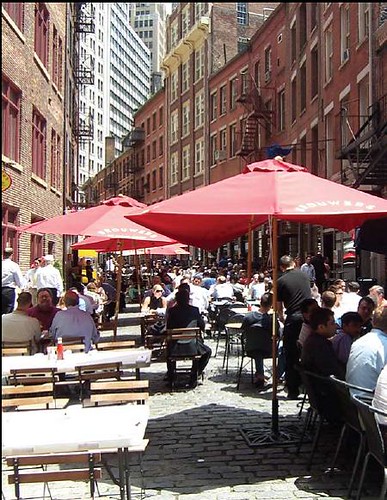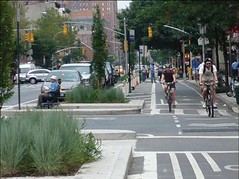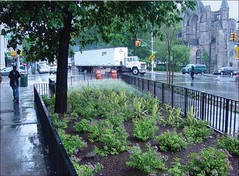Enviros should applaud NYC’s impressive new guidelines for complete, green streets

Posted June 10, 2009 at 1:28PM
New York City may have just become the state of the art when it comes to planning streets for people and the environment, not just cars and traffic. And I'm not sure the environmental community has noticed yet, which is a shame.
I guess that, if you want to lose a room, uttering the words "street design manual" may be a good way to do it. But streets matter a lot:
- They connect us where we need to go, no matter what our mode of travel.
- If welcoming to people, especially pedestrians, they help our cities attract life and investment inward to our existing communities, not outward to sprawl.
- If they are conducive to walking, transit, and bicycling, they encourage people to use those modes of transportation, rather than driving, which reduces carbon and other emissions.
- They promote public health through physical activity.
- If well designed, they can help protect watersheds by absorbing stormwater before it runs off into sewers.
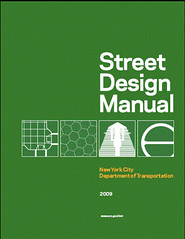 New York's new guidelines are so good that they could have been written by my friend Barbara McCann, executive director of the Complete Streets Coalition (NRDC is a member), which advocates streets for all people. They were published last month.
New York's new guidelines are so good that they could have been written by my friend Barbara McCann, executive director of the Complete Streets Coalition (NRDC is a member), which advocates streets for all people. They were published last month.
The new manual is the follow-up promised by the publication of last year's report, World Class Streets: Remaking New York City's Public Realm. That report was led by noted Danish architect and street expert Jan Gehl, and it explored the best of such international examples as Copenhagen, Melbourne, Lyon, London, and Barcelona. Gehl and his colleagues conducted extensive surveys of how New Yorkers use the city's public spaces, and addressed such issues as congested and obstructed sidewalks, the lack of street furniture, construction interference, closed facades abutting sidewalks, real and perceived safety, the relationship between pedestrians and transit, and more. It explicitly endorsed complete streets.
Written for the public, World Class Streets was not a technical, in-depth publication. But this is a subject on which pictures are indeed frequently more valuable than words, and the most significant thing about the report was that the city chose to do it.
The new Street Design Manual is the in-depth publication, 232 detailed and well-illustrated pages in length. It poses the solutions to all these issues, and it commits the city to a number of goals, including the following, just to name a few:
- Design local streets to be green, traffic-calmed environments that encourage walking, bicycling, and recreational activities.
- Design streets to encourage physical activity for all ages and populations by making walking, bicycling, and transit attractive and convenient.
- Minimize impermeable surfaces and maximize vegetation on streets. Street designs should use stormwater source controls and other best management practices (BMPs) wherever possible.
- Reduce the heat absorption of streets by maximizing tree canopy cover and utilizing paving materials with high Solar Reflectance Index (SRI) values when possible.
- Expand usable public open space by reallocating underutilized roadway space to create pedestrian plazas, expanded sidewalks, corner and mid-block curb extensions, and opportunities for green planted areas.
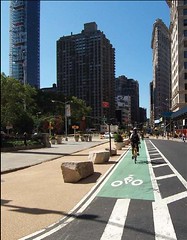 (Emphasis in original.) All the images accompanying this post are from the manual. And remember, folks, this is a publication by and for traffic engineers. This is big. As one blogger put it in his headline, "NYC Releases 2009 Street Design Manual, Pigs Fly."
(Emphasis in original.) All the images accompanying this post are from the manual. And remember, folks, this is a publication by and for traffic engineers. This is big. As one blogger put it in his headline, "NYC Releases 2009 Street Design Manual, Pigs Fly."
David W. Chen described the publication and its potential impact in the New York Times:
"Imagine narrow European-style roadways shared by pedestrians, cyclists and cars, all traveling at low speeds. Sidewalks made of recycled rubber in different colors under sleek energy-efficient lamps. Mini-islands jutting into the street, topped by trees and landscaping, designed to further slow traffic and add a dash of green.
"This is what New York City streets could look like, according to the Bloomberg administration, which has issued the city's first street design manual in an effort to make over the utilitarian 1970s-style streetscape that dominates the city.
"The Department of Transportation will begin reviewing development plans to see whether they align with the 232-page manual's guidelines, and promises that projects with these features will win approval quickly . . .
"Urban planners say that the document is long overdue, and that it promises to be as much a map to the future as it is a handbook for the present: getting people to think about streets as not just thoroughfares for cars, but as public spaces incorporating safety, aesthetics, environmental and community concerns."
Now you may applaud.
